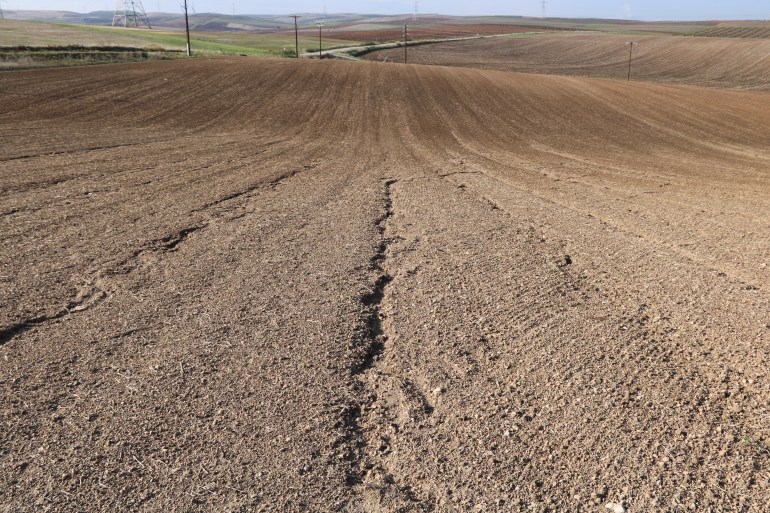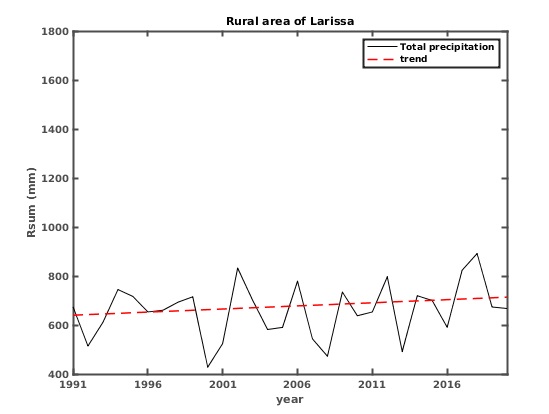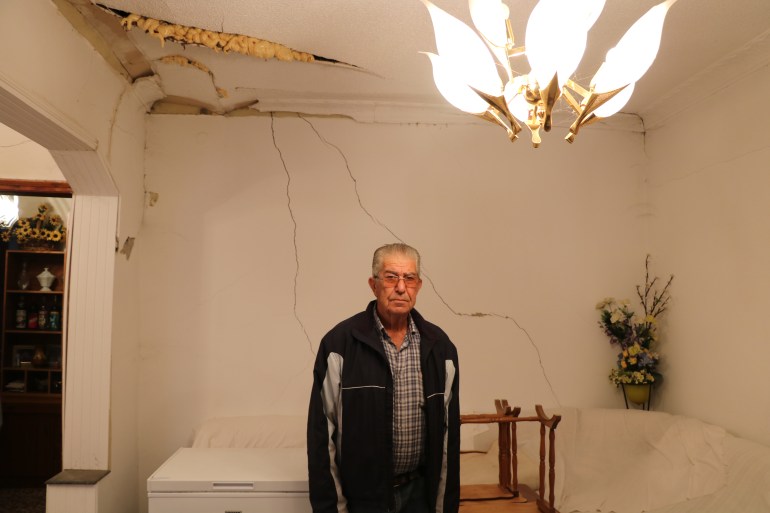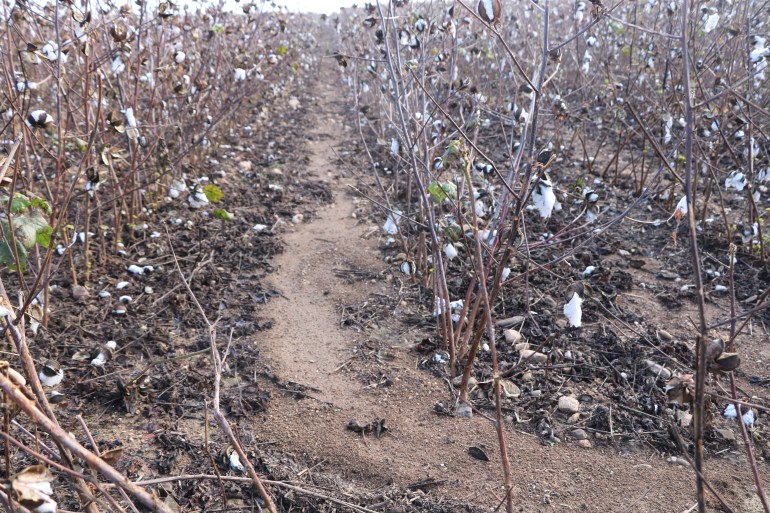Climate change and human error shrivel Greek agriculture
Climate change is now compounding decades of water mismanagement and unsustainable farming practices in Greece.

Thessaly, Greece – The farmers of Ampelonas in central Greece are headed for financial ruin. Last July, as a series of heatwaves struck the country, their electricity was cut off so they couldn’t irrigate their fields. Entire crops were lost.
“From an acre of pear trees, I didn’t collect a single fruit,” said Yiorgos Sakorrafas, president of the local farmers’ union. “Others lost alfalfa. Some harvested greatly reduced yields.”
Keep reading
list of 4 itemsHow can people displaced by climate change get justice?
Climate change and famine | Start Here
Climate change may already affect 85 percent of humanity
Electricity was cut off at such a critical time because Ampelonas and two nearby villages accumulated debts to the local water management authority of 3 million euros ($3.5m). A deal they negotiated with the regional government to foot the bill for that crucial July irrigation fell through.
Most of the villages’ debt represents the cost of electricity used to pump water from a centralised well in Mati Tyrnavou to local fields through an inefficient network of leaky pipes and ditches.
“The system is old and has fallen apart. So much water is lost on the way, that whereas our annual water bill should come to 500-550 euros ($580-$638) a hectare, it costs 800-1,000 euros ($928-$1160),” said Sakorrafas. “If this continues, we will all be ruined.”
The problems of Ampelonas are the problems of Greece writ small. Amplelonas lies in the plain of Thessaly, the country’s largest farming region, where climate change is now compounding decades of water mismanagement and unsustainable farming practices.
Fixing Thessaly’s water mismanagement has become urgent because of expected changes in climate. A Bank of Greece report in 2011 estimated that in a scenario in which no action was taken to combat or mitigate the effects of climate change, Greece would lose 2 percent of its annual economy by 2050 and 6 percent by the end of the century – a cumulative loss of more than 700 billion euros ($815bn), three and a half times its gross domestic product.
The largest share of that cost is to come from agriculture, the report said.
Scale of the problem
The high cost of building and maintaining centralised irrigation infrastructure – dams, reservoirs, pumping stations and distribution networks – led to many projects being abandoned across the decades.
Instead, governments allowed Thessaly’s farmers to dig their own wells and irrigate at will.
According to the government’s most recent Thessaly Water Management Plan, only 23 percent of the plain was irrigated through water management authorities. The remaining 77 percent was a free-for-all, punctured by 33,000 wells.
Over-pumping has led to the depletion of underground aquifers. Water tables were so low in some parts of Thessaly that crops did not fetch enough income to pay the cost of pumping, and many farmers abandoned their plots.
According to the Department of Agriculture at the University of Thessaly, total arable land in Greece has fallen from 3.6 million hectares to 3.2 million hectares (7.9 million acres) during the last decade, a loss of 11 percent. Thessaly alone has lost more than 60,000 hectares (148,000 acres), representing 13 percent of its arable land.
Water shortages are likely to be compounded by drought. In a worst-case scenario, the report forecast average temperatures in 2091-2100 will be 3.9C (7F) higher in winter and spring, 4.7C (8.5F) higher in autumn and 5.4C (9.7F) higher in summer.
Data compiled for this report by the Athens Observatory, which monitors weather across the country, confirmed the heat in Thessaly was rising. Average annual temperatures in Larissa, the Thessalian capital, have risen by almost 2C (3.6F) since 1990 – from just more than 20C to 22C (36F to 40F).
The Bank of Greece report also predicted that Thessaly’s rainfall will gradually diminish by 18 percent by the end of the century.
The Athens Observatory’s data showed that total annual rainfall has actually increased since 1990, but Kostas Lagouvardos, research director at the Observatory, warned that not all of that rain may come down in usable form. Part of it could take the form of extreme weather phenomena, flooding land and washing away soil.

The water problem
The government estimates Thessaly’s annual water deficit at 345 million tonnes. That is how much more water is being pumped from underground aquifers than is currently being replaced through rainfall. Across four decades, Thessaly’s farmers have overdrawn the aquifer by an estimated three billion tonnes.
Local water management authorities have been trying to make better use of surface water and reduce dependence on pumping. Perhaps the healthiest water management authority in the Thessaly plain was that of Karditsa, which served 8,000 farmers on 12,000 hectares (29,700 acres). Tucked in the plain’s southwest corner against the Pindos mountains, it has benefitted from the water of the Tavropos river, which was dammed in 1965.
The dam has made 50 million tonnes of water available for irrigation in the critical spring and summer months, but an antiquated distribution network of open canals and concrete channels leaked water. In addition, the water could not be used for efficient watering methods such as drip irrigation, in which perforated hoses are placed on the ground, because it was not pressurised. It was designed for use in giant sprinklers, which the authority’s director, Thanasis Markinos, called “an inefficient method incompatible with modern farming methods and best practices”.
Markinos reckoned that two-thirds of the water went to waste. “Currently, we lose more than 35 percent of water in leaks, and giant sprinklers lose 50-60 percent in evaporation,” he said. So of the 50 million tonnes, only about 18 million tonnes made it into the fields.
Markinos has said building it will cost 129m euros ($150mn). The environment ministry says some of this will come from the EU’s Recovery and Resilience Fund, and the rest from the private sector.
This is part of 900mn euros’ worth ($1bn) of irrigation infrastructure under consideration nationwide. The network is expected to start in late 2023 and take two years.

The new Karditsa network will resemble what existed on a smaller scale in the southeastern corner of the Thessaly plain. In 1988, a local prefect created a 200-hectare (500-acre) irrigation reservoir on public land. Almost a dozen more followed, each reservoir serving a particular village through a pressurised closed-pipe system.
Then in 2003, pressure from the environmental group World Life Fund for Nature led to the recreation of Lake Karla, which was drained in the 1950s, as a habitat for waterfowl. The lake was deemed full enough last year to start providing irrigation water to several villages.
“The last time we had a problem was 2001. Since then, the plain never went thirsty again,” said Nikos Stathis, who grows cotton and wheat on 20 hectares (49 acres) in the village of Kastri Ayias, one of the beneficiaries of the Lake Karla system.
“If these reservoirs hadn’t been built, we would all have left. We’d be in Australia or Germany,” added his colleague, Theodoros Dalakouras, who grows cotton, alfalfa and grain on 100 hectares (247 acres).

‘At each other’s throats’
Kostas Kalfountzos, a farmer who did abandon the profession to become a real estate agent, remembered the drought of 2001, when much of the modern system was not yet in place. “Every night people were at each other’s throats in the fields, arguing over who would get an hour’s irrigation to save his crop,” he said.
Where the water table is humbled, abandonment has increasingly been the order of the day. The village of Niki, a few kilometres away from Kastri Ayias, for example, was off the water grid. Some of its wells have reached a depth of some 400 metres (1,300 feet), and the aquifer beneath the village has been so depleted that the ground has begun to subside.
Athanasios Datsios’s house lay across one of the rifts that undermine Niki.
One Saturday in 1998, he went out for a walk with his wife. “When we returned, we saw that kitchen tiles had fallen onto the floor. We didn’t know what had happened. We stuck them back on, but gradually cracks appeared on the floor… then the ceilings started opening up, and then the walls started tearing up.”
Datsios’s living room is visibly disintegrating around him. His wife passed away this year, never having seen her home repaired, and he was gloomy about his own prospects of outliving the decay.

Losing the soil
Nikos Danalatos, professor of sustainable agriculture at the University of Thessaly, said water mismanagement was only one aspect of intensive agriculture destroying the land.
Much of Thessaly consists of hills, which were covered in forest until about a century ago. He said tilling these inclines with heavy machinery breaks down the soil’s organic matter – decomposing or decayed plants that provide nutrients, stabilise soil structure and help it retain water.
Leaving fields bare in winter made the problem worse, he said, because raindrops acted as tiny centrifuges on bare soil, spinning out its smallest particles and leaving sand and rock.
Both the chemical and physical breakdown of the soil have led to its erosion in Thessaly, and eventual desertification, Danalatos said.
“In these areas, 20-30 centimetres (7.9 – 11.8 inches) of soil are left, compared to a metre at the beginning of the 20th century. If they are not protected, if they are not properly cultivated, with crop rotation and the maintenance of some vegetation during winter, we will lose more and more of them. We’re currently losing about 20,000 hectares a year, and a total of 900,000 hectares (2.2 million acres) since 1980,” he said.
The action of recent rainfall was visible on bare fields, where rivulets dug furrows in the soil or carried lighter particles of soil downhill.
Danalatos said artificial fertiliser and mechanisation temporarily produced higher yields after World War II, disguising the problems they were creating.
“The actual fertility of fields went up, but the potential fertility was falling,” he said. “At some point, in the 1990s, these two trends met. I would say to farmers, ‘you’re losing fertility’. And they’d say, ‘What are you talking about? Our yields are increasing’. When actual and potential fertility met, they both fell in lockstep. And farmers would say, ‘What’s going on? I’m using more fertiliser, I’m using more water, and yields are falling’. That is when desertification showed its teeth.”
Danalatos said these trends are reversible by sowing legumes in winter, which add nitrogen to the soil, and ploughing the plants into the soil when they flower in spring, to restore lost organic matter.
Experiments he has carried out during the past 10 years suggest fields sustainably farmed in this way reduce water consumption by half, increase yields by more than half, and do away with costly artificial fertiliser altogether.
Asked why Thessaly’s farmers have not adopted these methods, he said, “I’ve talked about it in conferences. No one is interested.”

Fixing the problem
The government has been weighing in to re-educate farmers, extend irrigation networks, and shut down wells. During the next seven years, the agriculture ministry will be armed with a once-in-a-century war chest of 22 billion euros ($26bn) from the EU’s Common Agricultural Policy and the post-COVID Resilience and Recovery Fund.
“Our basic goal is to create a new attitude among farmers of respect towards the environment,” said Agriculture Minister Spilios Livanos in written comments to Al Jazeera.
Livanos said his ministry has helped found six new vocational schools teaching agricultural courses, and he was thinking of expanding environmental awareness through secondary education, as well.
Also among the ministry’s goals is to pour money into infrastructure that will help conserve and store water.
A twin dam project begun in the 1990s to divert 250 million tonnes of water from the Acheloos river in western Greece to Thessaly is being revived. The project was struck down in court six times due to concerns about the environmental impact of the diversion on the Acheloos valley and delicate delta ecosystem. One dam was built, but its reservoir was never filled. A second is half-built.
“The government has committed to look into the issues of a partial diversion of the Acheloos,” said Konstantinos Aravosis, general secretary for the environment and water resources at the environment ministry. “The transfer of water from the Acheloos to Thessaly will reduce the severity of Thessaly’s water problem,” he told Al Jazeera. Aravosis expected the dams to be operating in five to six years.
Some have been sceptical about how much any government can do.
Konstantinos Goumas was a young agriculture graduate in the mid-1980s when he helped design a dam to be built near his native Elassona in northwest Thessaly. Work began in 2000. When it ended six years later, only the dam’s spillway and toe drain tunnel had been built. Elassona’s farmers have relied on their own wells.
“I don’t think there was any shortage of funds to complete the dam,” said Goumas, who has spent much of his life advocating for better water infrastructure. “The project just got lost in the state bureaucracy.”
The Thessaly Water Management Plan still relies on 120 million tonnes of water to come from yet-to-be-designed infrastructure.
Goumas, who heads the Committee for the Solution of Thessaly’s Water Problem, spoke to the government experts who had drafted the plan.
“They said we’d build reservoirs. When we asked where they would place them, they had no idea. You have to have a plan for where the water will come from to fill the ponds, and how it will reach the farms.”
Livanos was light on the details of his anti-desertification plan, but his thrust was clear.
“Climate change, which is now a climate crisis, involves us all. There is no room for inaction,” he said. “The green transition is now a necessity.”
![Greece [Please do not use]](/wp-content/uploads/2021/10/IMG_9771.jpg?w=770&resize=770%2C513)